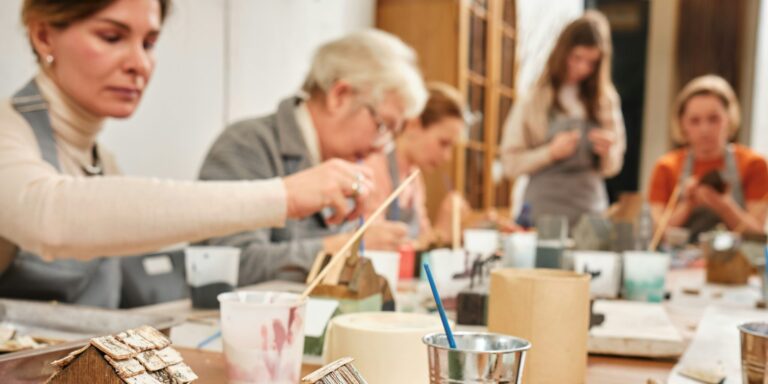The Smithsonian’s Renwick Gallery has unveiled a captivating new exhibition, “State Fairs: Growing American Craft,” which celebrates the artistic and creative culture that flourishes at state fairs across the United States. This exhibition, which is open through September 7, 2026, brings together more than 240 works of art, providing visitors with an immersive experience that explores the intersection of tradition, community, and craftsmanship that defines these uniquely American events. By showcasing works from 15 state fairs, curator Mary Savig and her team have created an exhibition that highlights the diverse range of artistic expression found at these fairs, where art, entertainment, and competition converge.
The exhibit features a variety of works, ranging from large, eye-catching installations to smaller, more intricate pieces. Among the most striking pieces are the whimsical and oversized works that have become synonymous with the spectacle of state fairs. Visitors will find the towering, size-96 boots worn by the legendary Big Tex, a beloved symbol of the Texas State Fair. There is also the iconic butter cow from Iowa, a work that has become a symbol of the state’s agricultural heritage and the creativity that emerges from the fair. These larger-than-life sculptures are not only playful and bold but also carry deep cultural significance, representing the spirit of fun and competition that define state fairs.
Alongside these massive works are smaller-scale pieces, each a testament to the fine craftsmanship and attention to detail that define traditional American craft. The exhibition includes seed mosaics, woven tapestries, and intricately crafted pottery and textiles. These delicate pieces showcase the talent and skill of artisans who dedicate hours, sometimes days, to producing works that are not only functional but are also expressions of personal creativity and cultural heritage. These smaller pieces help balance the larger-than-life installations, offering visitors a chance to appreciate the diversity of artistic techniques and the rich history behind many of these traditions.
Read Also: https://nvtoday.com/los-angeles-art-scene-flourishes-with-diverse-exhibitions-in-august/
Mary Savig and her team of researchers spent considerable time visiting and studying 15 state fairs across the country to gather these works. The exhibition serves as a celebration of the U.S.’s 250th birthday, with each piece telling the story of America’s diverse cultural landscape through the lens of its state fair traditions. The research behind the exhibit emphasizes the importance of state fairs as spaces where local artisans, as well as professional artists, can come together and share their craft. These fairs are not only about competition but also about community, where people of all backgrounds can showcase their skills, learn from each other, and celebrate their cultural identities.
What makes this exhibition so fascinating is how it blends traditional crafts with contemporary art. State fairs have long been venues for displaying the kinds of skills passed down through generations, such as quilting, woodworking, and other handmade goods. However, the exhibition also highlights how these traditions continue to evolve and merge with modern artistic practices. For instance, alongside the quilts and pottery are contemporary works that incorporate new technologies or innovative approaches to traditional techniques. This blending of the old and the new reflects the way state fairs continue to serve as platforms for both preserving traditional crafts and encouraging new artistic experimentation.
Through its thoughtfully curated displays, “State Fairs: Growing American Craft” is not just an exhibition of art; it is a tribute to the cultural significance of state fairs in American life. These fairs are more than just venues for entertainment; they are spaces where people connect, share, and learn from each other. For artisans, they are opportunities to showcase their skills, get recognition, and contribute to the cultural fabric of their communities. For visitors, they are places to witness the creativity that emerges from local traditions and gain insight into the diverse artistic practices that define American craft.
The exhibition also speaks to the larger role that craft fairs have played in the artistic journeys of both community artisans and professional artists. It demonstrates how state fairs provide a crucial space for emerging artists to be seen and appreciated, often helping them gain the exposure that leads to further opportunities in the art world. For many artisans, participating in a state fair is a rite of passage, an acknowledgment of their craft, and a chance to be part of something much larger than themselves.
As visitors walk through the exhibition, they are invited to experience the creativity, ingenuity, and cultural heritage that state fairs have come to symbolize. From the grand, spectacle-driven installations to the finely crafted and meticulously detailed works of art, “State Fairs: Growing American Craft” is an exploration of the ways in which art connects communities and fosters a sense of shared identity. The exhibition also provides a window into how the arts are passed down, reinterpreted, and transformed over generations, ensuring that the traditions of American craftsmanship continue to thrive in both traditional and contemporary forms.
The exhibition is a fitting tribute to the spirit of America’s state fairs, blending the nostalgic with the modern, and offering a glimpse into the future of craft and artistic expression. Whether one is drawn to the sheer scale and spectacle of Big Tex’s boots or the quiet beauty of a handwoven tapestry, the exhibition provides a comprehensive and deeply engaging exploration of American craftsmanship at its finest.


